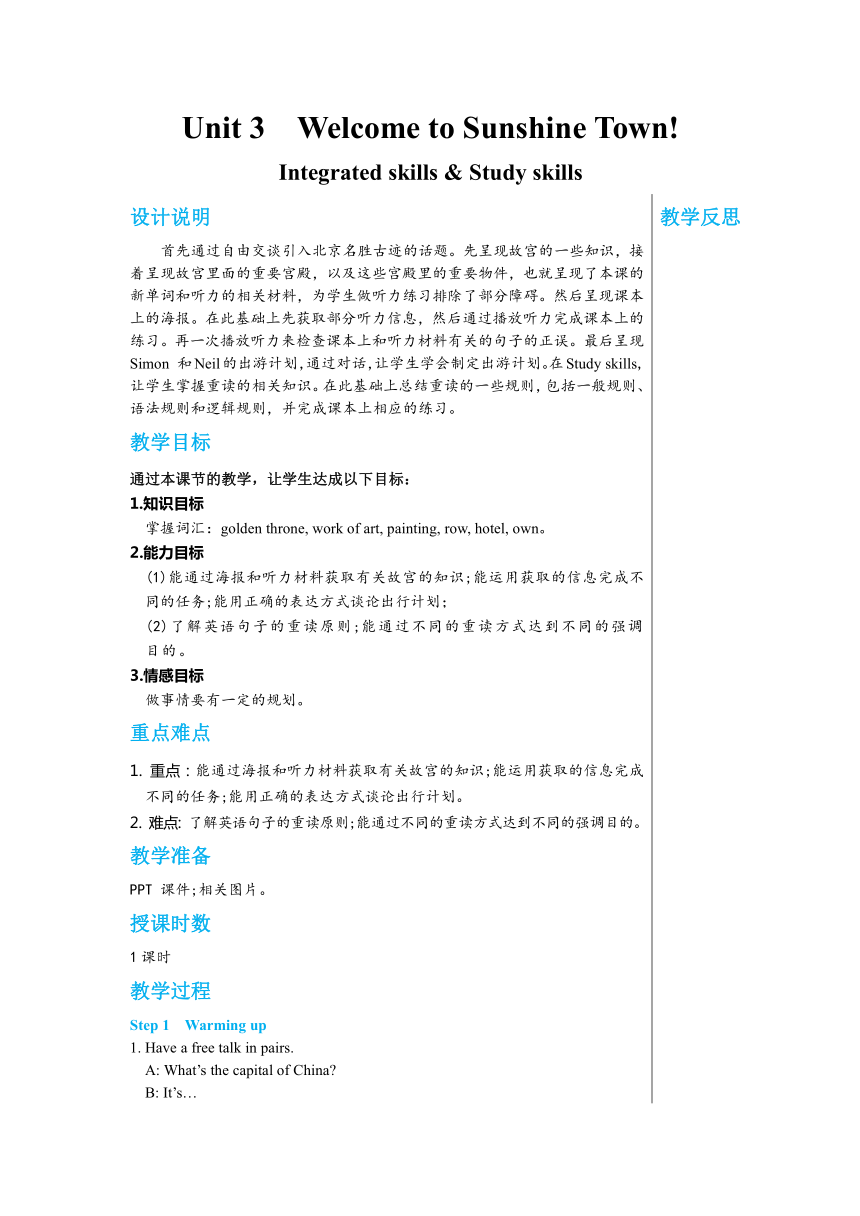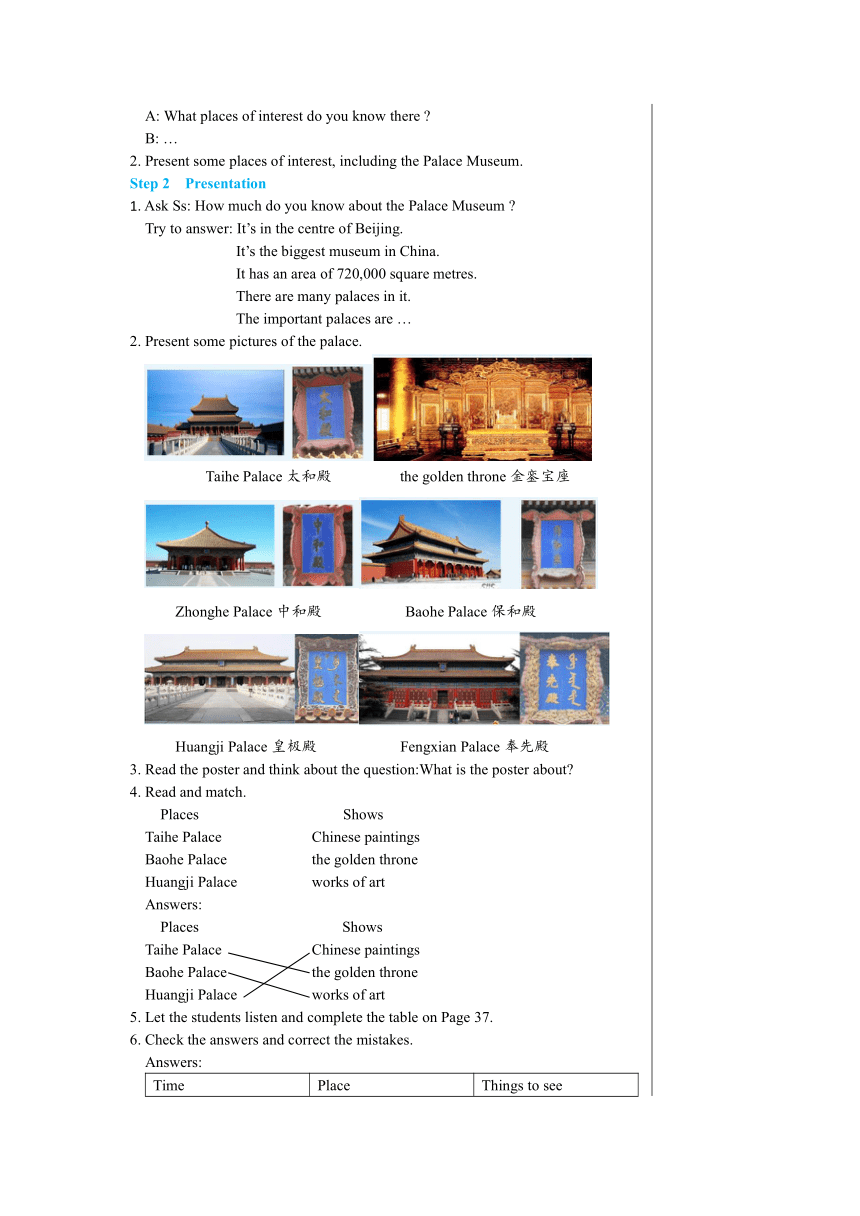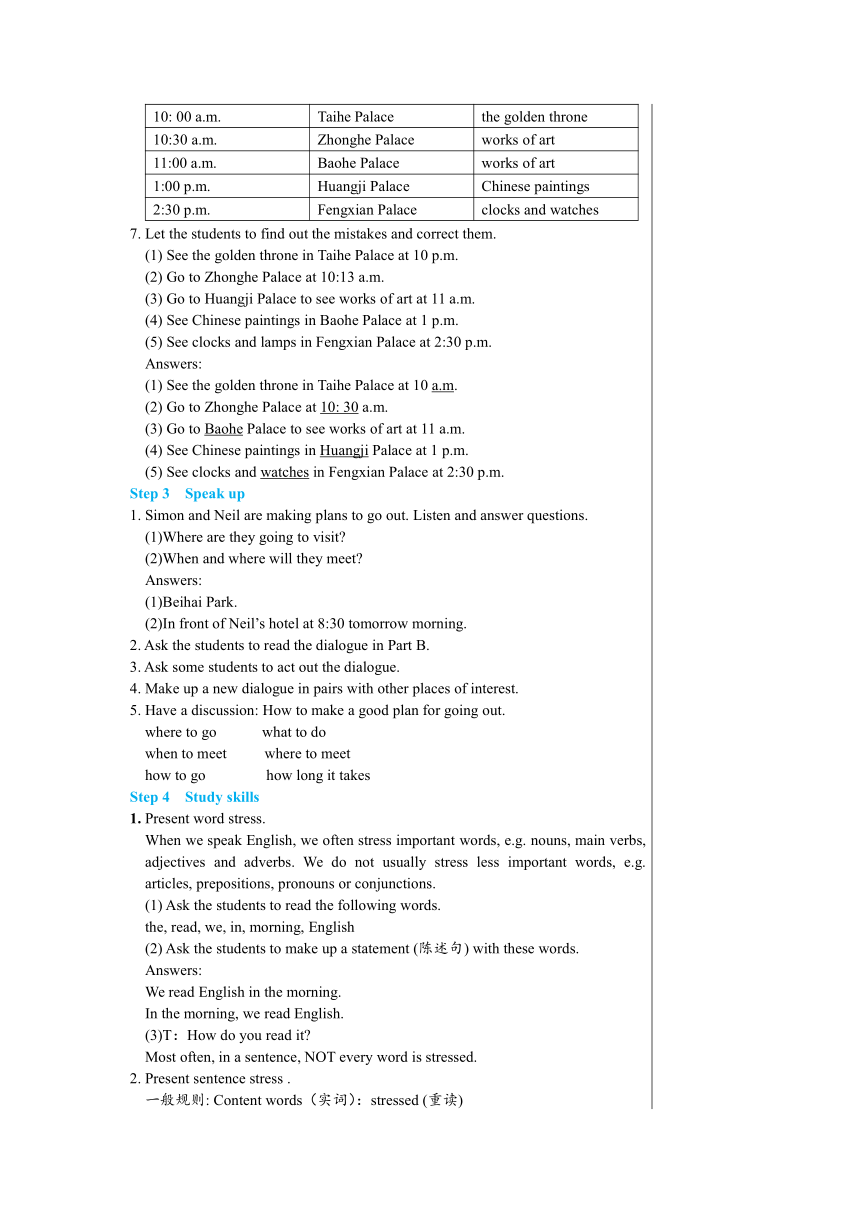Unit 3 Integrated skills & Study skills教学详案-译林牛津版初中英语七年级(下)
文档属性
| 名称 | Unit 3 Integrated skills & Study skills教学详案-译林牛津版初中英语七年级(下) |  | |
| 格式 | docx | ||
| 文件大小 | 1.2MB | ||
| 资源类型 | 试卷 | ||
| 版本资源 | 牛津译林版 | ||
| 科目 | 英语 | ||
| 更新时间 | 2024-02-21 19:45:06 | ||
图片预览



文档简介
Unit 3 Welcome to Sunshine Town!
Integrated skills & Study skills
设计说明 首先通过自由交谈引入北京名胜古迹的话题。先呈现故宫的一些知识,接着呈现故宫里面的重要宫殿,以及这些宫殿里的重要物件,也就呈现了本课的新单词和听力的相关材料,为学生做听力练习排除了部分障碍。然后呈现课本上的海报。在此基础上先获取部分听力信息,然后通过播放听力完成课本上的练习。再一次播放听力来检查课本上和听力材料有关的句子的正误。最后呈现Simon 和Neil的出游计划,通过对话,让学生学会制定出游计划。在Study skills,让学生掌握重读的相关知识。在此基础上总结重读的一些规则,包括一般规则、语法规则和逻辑规则,并完成课本上相应的练习。 教学目标 通过本课节的教学,让学生达成以下目标: 1.知识目标 掌握词汇:golden throne, work of art, painting, row, hotel, own。 2.能力目标 (1)能通过海报和听力材料获取有关故宫的知识;能运用获取的信息完成不同的任务;能用正确的表达方式谈论出行计划; (2)了解英语句子的重读原则;能通过不同的重读方式达到不同的强调目的。 3.情感目标 做事情要有一定的规划。 重点难点 1. 重点:能通过海报和听力材料获取有关故宫的知识;能运用获取的信息完成不同的任务;能用正确的表达方式谈论出行计划。 2. 难点: 了解英语句子的重读原则;能通过不同的重读方式达到不同的强调目的。 教学准备 PPT 课件;相关图片。 授课时数 1课时 教学过程 Step 1 Warming up 1. Have a free talk in pairs. A: What’s the capital of China B: It’s… A: What places of interest do you know there B: … 2. Present some places of interest, including the Palace Museum. Step 2 Presentation 1. Ask Ss: How much do you know about the Palace Museum Try to answer: It’s in the centre of Beijing. It’s the biggest museum in China. It has an area of 720,000 square metres. There are many palaces in it. The important palaces are … 2. Present some pictures of the palace. Taihe Palace太和殿 the golden throne金銮宝座 Zhonghe Palace中和殿 Baohe Palace保和殿 Huangji Palace皇极殿 Fengxian Palace奉先殿 3. Read the poster and think about the question:What is the poster about 4. Read and match. Places Shows Taihe Palace Chinese paintings Baohe Palace the golden throne Huangji Palace works of art Answers: Places Shows Taihe Palace Chinese paintings Baohe Palace the golden throne Huangji Palace works of art 5. Let the students listen and complete the table on Page 37. 6. Check the answers and correct the mistakes. Answers: TimePlaceThings to see10: 00 a.m.Taihe Palacethe golden throne10:30 a.m.Zhonghe Palaceworks of art11:00 a.m.Baohe Palaceworks of art1:00 p.m.Huangji PalaceChinese paintings2:30 p.m.Fengxian Palaceclocks and watches
7. Let the students to find out the mistakes and correct them. (1) See the golden throne in Taihe Palace at 10 p.m. (2) Go to Zhonghe Palace at 10:13 a.m. (3) Go to Huangji Palace to see works of art at 11 a.m. (4) See Chinese paintings in Baohe Palace at 1 p.m. (5) See clocks and lamps in Fengxian Palace at 2:30 p.m. Answers: (1) See the golden throne in Taihe Palace at 10 a.m. (2) Go to Zhonghe Palace at 10: 30 a.m. (3) Go to Baohe Palace to see works of art at 11 a.m. (4) See Chinese paintings in Huangji Palace at 1 p.m. (5) See clocks and watches in Fengxian Palace at 2:30 p.m. Step 3 Speak up 1. Simon and Neil are making plans to go out. Listen and answer questions. (1)Where are they going to visit (2)When and where will they meet Answers: (1)Beihai Park. (2)In front of Neil’s hotel at 8:30 tomorrow morning. 2. Ask the students to read the dialogue in Part B. 3. Ask some students to act out the dialogue. 4. Make up a new dialogue in pairs with other places of interest. 5. Have a discussion: How to make a good plan for going out. where to go what to do when to meet where to meet how to go how long it takes Step 4 Study skills 1. Present word stress. When we speak English, we often stress important words, e.g. nouns, main verbs, adjectives and adverbs. We do not usually stress less important words, e.g. articles, prepositions, pronouns or conjunctions. (1) Ask the students to read the following words. the, read, we, in, morning, English (2) Ask the students to make up a statement (陈述句) with these words. Answers: We read English in the morning. In the morning, we read English. (3)T:How do you read it Most often, in a sentence, NOT every word is stressed. 2. Present sentence stress . 一般规则: Content words(实词):stressed (重读) Empty words(虚词):unstressed(不重读) In a sentence, we emphasize (强调) the important part by stressing the key information. The key information is called “focus”(重点). Different focuses,different meanings.(重点不同,含义各异) (1)Stress correct information according to the tips given. (2)Part A Listen and pay attention to the stressed words. 3. Present Logical stress.(逻辑重音) In a sentence, the focus or contrastive part (对比成分)is more important than the other information and it should be stressed. Part B Read the sentences below. Stress the different words according to the meanings you want to express. (1) I want to buy a CD at the bookshop. a I am talking about what I want to do, not what I do not want to do. b I am talking about a bookshop, not another kind of shop. c I am talking about a CD, not something else. (2) Daniel sometimes watches TV on Sunday morning. a I am talking about watching TV, not another activity. b I am talking about Daniel, not another student in the class. c I am talking about Sunday morning, not another morning. Step 5 Language points 1. works of art 艺术品 works of art意为“艺术品”, 此处 works是work的复数形式。work当“作品,著作”讲时,为可数名词。 Wang Hai likes to collect works of art.王海喜欢收藏艺术品。 I want to learn more about Mo Yan’s works.我想了解更多有关莫言的著作。 【拓展】(1)work意为“工作,劳动”时,为不可数名词。 They have much work to do.他们有许多工作要做。 (2)work也可作为不及物动词,意为“工作”。 He works in a factory.他在一家工厂工作。 2. We can row a boat on the lake.我们可以在湖上划船。 row 此处用作及物动词,意为“划(船)”, 也可用作不及物动词,意为“划船”。We often row our boat out to sea.我们经常划船出海。 She is rowing across the lake.她正划船到湖对面。 【拓展】rowing 用作不可数名词,意为“划船,划船运动”。go rowing 意为“去划船”。 Let’s go rowing now!现在咱们去划船吧! 3. How far is it from the hotel 它离宾馆有多远 how far 意为“多远”,用于提问距离。 —How far is it from here to the park 从这里到那个公园有多远 —It is two kilometres.两千米远。 4. Mr Li owns a four-bedroom flat.李先生拥有一套四室的公寓。 own 此处用作及物动词,意为“拥有,所有”,相当于have。 I own a new house.=I have a new house.我有一栋新房子。 He owned everything.他拥有一切。 【拓展】owner 可数名词,意为“主人,物主”。 He is the owner of the car.他是这辆小汽车的主人。 5. I am talking about what I want to do, not what I do not want to do. 我正在谈论我想要做的事情,不是我不想做的事情。 talk about 意为“谈论,讨论”。 What are they talking about 他们正在谈论什么 【拓展】talk to/with sb.“与某人交谈”。 Our teachers often talk with our parents. 我们的老师经常与我们的父母交谈。 6. I am talking about a bookshop, not another kind of shop. 我正在谈论书店,不是另外一种商店。 辨析:another, other, the other, others与 the others another又一个,另一个泛指三者或三者以上中的另一个人或物,后接单数名词,也可单独使用other别的,其他的指不确定的其他的或别的人或物。不可单独使用,后面常跟复数名词the other另一个指两者中的另一个。常构成 one...the other...,意为“一个……另一个……others其他的,别的,其余的指不确定的其他的人或事物。可单独使用,后面不跟名词。the others其余的,剩余的人或事物指在明确的(固定的)范围中,除去一部分,剩下的那部分人或事物。some...the others...意为“一些……,其他的……”
I don’t like this jacket. Please show me another. 我不喜欢这件夹克衫,请给我拿另一件看看。 Other people went to the supermarket.其他的人去了超市。 He has two sisters. One is a doctor; the other is a teacher. 他有两个姐姐。一个是医生,另一个是教师。 There are lots of people in the park. Some are boating, some are dancing, and others are playing chess. 公园里有许多人,一些在划船,一些在跳舞,还有一些在下国际象棋。 There are ten cars here. Six (of them) are red, and the others are black. 这儿有10辆汽车,6辆是红色的,其余的是黑色的。 Step 6 Homework Remember the words and phrases. Recite Speak Up. 当堂达标 Ⅰ. 单项选择 1. That hospital is not far from here. You can go there a bike. A. on B. by C. in D. at 2. This is a car. A. visitors B. visitor’s C. visitor D. visitors’ 3. — is it from Lanzhou to Lhasa —It’s about 2,160 kilometres. A. How often B. How far C. How long D. How many 4. — This room is too small. I’d like to ask for . —Sure. We have rooms available here. A. another B. the other C. one D. it 5. There are lots of fine in the new history museum. A. work of art B. works of art C. work of arts D. works of arts 6. — Is this notebook — Yes. It is . A. theirs; their B. hers, his C. your; mine D. your; my 7. He doesn’t have books. But he can choose books he likes in the library. A. any; any B. some; some C. some; any D. any; some Ⅱ.根据句意用所给单词的适当形式填空 1. The Palace Museum is a good place (visit) in Beijing. 2. There are a lot of nice clocks and (watch) in the shop. 3. —Are there a lot of things (see) there — Yes, there are. 4. Hurry up! It’s still two (hour) walk from here to the airport. 5. This book is one of the famous (work) by Lu Xun. 6. We are having two (meet) in the next two weeks. 7. We often go (row) on Sundays. 8. Some boys are playing basketball, and (other) are playing football. 9. It’s twenty (minute) ride from here to the library. 10. There are lots of Chinese (draw) in the Huangji Palace. Answers: Ⅰ. 1—5ABBAB 6—7 CD Ⅱ. 1. to visit 2. watches 3. to see 4. hours’ 5. works 6. meetings 7. rowing 8. others 9. minutes’ 10. drawings 板书设计 Unit 3 Welcome to Sunshine Town! Integrated skills & Study skillsgolden throne, work of art, row, painting, hotel, ownworks of art 艺术品 work 作品 ,可数名词 a work of art work工作, 不可数名词 hard work row (v. 划) a boat=go boating in Row (n.排,行) 1=in the first row a(n)+数词+-+单数名词(前置定语)+名词=a(n)+名词+with+数词+复数名词 (后置定语)
教学反思
Integrated skills & Study skills
设计说明 首先通过自由交谈引入北京名胜古迹的话题。先呈现故宫的一些知识,接着呈现故宫里面的重要宫殿,以及这些宫殿里的重要物件,也就呈现了本课的新单词和听力的相关材料,为学生做听力练习排除了部分障碍。然后呈现课本上的海报。在此基础上先获取部分听力信息,然后通过播放听力完成课本上的练习。再一次播放听力来检查课本上和听力材料有关的句子的正误。最后呈现Simon 和Neil的出游计划,通过对话,让学生学会制定出游计划。在Study skills,让学生掌握重读的相关知识。在此基础上总结重读的一些规则,包括一般规则、语法规则和逻辑规则,并完成课本上相应的练习。 教学目标 通过本课节的教学,让学生达成以下目标: 1.知识目标 掌握词汇:golden throne, work of art, painting, row, hotel, own。 2.能力目标 (1)能通过海报和听力材料获取有关故宫的知识;能运用获取的信息完成不同的任务;能用正确的表达方式谈论出行计划; (2)了解英语句子的重读原则;能通过不同的重读方式达到不同的强调目的。 3.情感目标 做事情要有一定的规划。 重点难点 1. 重点:能通过海报和听力材料获取有关故宫的知识;能运用获取的信息完成不同的任务;能用正确的表达方式谈论出行计划。 2. 难点: 了解英语句子的重读原则;能通过不同的重读方式达到不同的强调目的。 教学准备 PPT 课件;相关图片。 授课时数 1课时 教学过程 Step 1 Warming up 1. Have a free talk in pairs. A: What’s the capital of China B: It’s… A: What places of interest do you know there B: … 2. Present some places of interest, including the Palace Museum. Step 2 Presentation 1. Ask Ss: How much do you know about the Palace Museum Try to answer: It’s in the centre of Beijing. It’s the biggest museum in China. It has an area of 720,000 square metres. There are many palaces in it. The important palaces are … 2. Present some pictures of the palace. Taihe Palace太和殿 the golden throne金銮宝座 Zhonghe Palace中和殿 Baohe Palace保和殿 Huangji Palace皇极殿 Fengxian Palace奉先殿 3. Read the poster and think about the question:What is the poster about 4. Read and match. Places Shows Taihe Palace Chinese paintings Baohe Palace the golden throne Huangji Palace works of art Answers: Places Shows Taihe Palace Chinese paintings Baohe Palace the golden throne Huangji Palace works of art 5. Let the students listen and complete the table on Page 37. 6. Check the answers and correct the mistakes. Answers: TimePlaceThings to see10: 00 a.m.Taihe Palacethe golden throne10:30 a.m.Zhonghe Palaceworks of art11:00 a.m.Baohe Palaceworks of art1:00 p.m.Huangji PalaceChinese paintings2:30 p.m.Fengxian Palaceclocks and watches
7. Let the students to find out the mistakes and correct them. (1) See the golden throne in Taihe Palace at 10 p.m. (2) Go to Zhonghe Palace at 10:13 a.m. (3) Go to Huangji Palace to see works of art at 11 a.m. (4) See Chinese paintings in Baohe Palace at 1 p.m. (5) See clocks and lamps in Fengxian Palace at 2:30 p.m. Answers: (1) See the golden throne in Taihe Palace at 10 a.m. (2) Go to Zhonghe Palace at 10: 30 a.m. (3) Go to Baohe Palace to see works of art at 11 a.m. (4) See Chinese paintings in Huangji Palace at 1 p.m. (5) See clocks and watches in Fengxian Palace at 2:30 p.m. Step 3 Speak up 1. Simon and Neil are making plans to go out. Listen and answer questions. (1)Where are they going to visit (2)When and where will they meet Answers: (1)Beihai Park. (2)In front of Neil’s hotel at 8:30 tomorrow morning. 2. Ask the students to read the dialogue in Part B. 3. Ask some students to act out the dialogue. 4. Make up a new dialogue in pairs with other places of interest. 5. Have a discussion: How to make a good plan for going out. where to go what to do when to meet where to meet how to go how long it takes Step 4 Study skills 1. Present word stress. When we speak English, we often stress important words, e.g. nouns, main verbs, adjectives and adverbs. We do not usually stress less important words, e.g. articles, prepositions, pronouns or conjunctions. (1) Ask the students to read the following words. the, read, we, in, morning, English (2) Ask the students to make up a statement (陈述句) with these words. Answers: We read English in the morning. In the morning, we read English. (3)T:How do you read it Most often, in a sentence, NOT every word is stressed. 2. Present sentence stress . 一般规则: Content words(实词):stressed (重读) Empty words(虚词):unstressed(不重读) In a sentence, we emphasize (强调) the important part by stressing the key information. The key information is called “focus”(重点). Different focuses,different meanings.(重点不同,含义各异) (1)Stress correct information according to the tips given. (2)Part A Listen and pay attention to the stressed words. 3. Present Logical stress.(逻辑重音) In a sentence, the focus or contrastive part (对比成分)is more important than the other information and it should be stressed. Part B Read the sentences below. Stress the different words according to the meanings you want to express. (1) I want to buy a CD at the bookshop. a I am talking about what I want to do, not what I do not want to do. b I am talking about a bookshop, not another kind of shop. c I am talking about a CD, not something else. (2) Daniel sometimes watches TV on Sunday morning. a I am talking about watching TV, not another activity. b I am talking about Daniel, not another student in the class. c I am talking about Sunday morning, not another morning. Step 5 Language points 1. works of art 艺术品 works of art意为“艺术品”, 此处 works是work的复数形式。work当“作品,著作”讲时,为可数名词。 Wang Hai likes to collect works of art.王海喜欢收藏艺术品。 I want to learn more about Mo Yan’s works.我想了解更多有关莫言的著作。 【拓展】(1)work意为“工作,劳动”时,为不可数名词。 They have much work to do.他们有许多工作要做。 (2)work也可作为不及物动词,意为“工作”。 He works in a factory.他在一家工厂工作。 2. We can row a boat on the lake.我们可以在湖上划船。 row 此处用作及物动词,意为“划(船)”, 也可用作不及物动词,意为“划船”。We often row our boat out to sea.我们经常划船出海。 She is rowing across the lake.她正划船到湖对面。 【拓展】rowing 用作不可数名词,意为“划船,划船运动”。go rowing 意为“去划船”。 Let’s go rowing now!现在咱们去划船吧! 3. How far is it from the hotel 它离宾馆有多远 how far 意为“多远”,用于提问距离。 —How far is it from here to the park 从这里到那个公园有多远 —It is two kilometres.两千米远。 4. Mr Li owns a four-bedroom flat.李先生拥有一套四室的公寓。 own 此处用作及物动词,意为“拥有,所有”,相当于have。 I own a new house.=I have a new house.我有一栋新房子。 He owned everything.他拥有一切。 【拓展】owner 可数名词,意为“主人,物主”。 He is the owner of the car.他是这辆小汽车的主人。 5. I am talking about what I want to do, not what I do not want to do. 我正在谈论我想要做的事情,不是我不想做的事情。 talk about 意为“谈论,讨论”。 What are they talking about 他们正在谈论什么 【拓展】talk to/with sb.“与某人交谈”。 Our teachers often talk with our parents. 我们的老师经常与我们的父母交谈。 6. I am talking about a bookshop, not another kind of shop. 我正在谈论书店,不是另外一种商店。 辨析:another, other, the other, others与 the others another又一个,另一个泛指三者或三者以上中的另一个人或物,后接单数名词,也可单独使用other别的,其他的指不确定的其他的或别的人或物。不可单独使用,后面常跟复数名词the other另一个指两者中的另一个。常构成 one...the other...,意为“一个……另一个……others其他的,别的,其余的指不确定的其他的人或事物。可单独使用,后面不跟名词。the others其余的,剩余的人或事物指在明确的(固定的)范围中,除去一部分,剩下的那部分人或事物。some...the others...意为“一些……,其他的……”
I don’t like this jacket. Please show me another. 我不喜欢这件夹克衫,请给我拿另一件看看。 Other people went to the supermarket.其他的人去了超市。 He has two sisters. One is a doctor; the other is a teacher. 他有两个姐姐。一个是医生,另一个是教师。 There are lots of people in the park. Some are boating, some are dancing, and others are playing chess. 公园里有许多人,一些在划船,一些在跳舞,还有一些在下国际象棋。 There are ten cars here. Six (of them) are red, and the others are black. 这儿有10辆汽车,6辆是红色的,其余的是黑色的。 Step 6 Homework Remember the words and phrases. Recite Speak Up. 当堂达标 Ⅰ. 单项选择 1. That hospital is not far from here. You can go there a bike. A. on B. by C. in D. at 2. This is a car. A. visitors B. visitor’s C. visitor D. visitors’ 3. — is it from Lanzhou to Lhasa —It’s about 2,160 kilometres. A. How often B. How far C. How long D. How many 4. — This room is too small. I’d like to ask for . —Sure. We have rooms available here. A. another B. the other C. one D. it 5. There are lots of fine in the new history museum. A. work of art B. works of art C. work of arts D. works of arts 6. — Is this notebook — Yes. It is . A. theirs; their B. hers, his C. your; mine D. your; my 7. He doesn’t have books. But he can choose books he likes in the library. A. any; any B. some; some C. some; any D. any; some Ⅱ.根据句意用所给单词的适当形式填空 1. The Palace Museum is a good place (visit) in Beijing. 2. There are a lot of nice clocks and (watch) in the shop. 3. —Are there a lot of things (see) there — Yes, there are. 4. Hurry up! It’s still two (hour) walk from here to the airport. 5. This book is one of the famous (work) by Lu Xun. 6. We are having two (meet) in the next two weeks. 7. We often go (row) on Sundays. 8. Some boys are playing basketball, and (other) are playing football. 9. It’s twenty (minute) ride from here to the library. 10. There are lots of Chinese (draw) in the Huangji Palace. Answers: Ⅰ. 1—5ABBAB 6—7 CD Ⅱ. 1. to visit 2. watches 3. to see 4. hours’ 5. works 6. meetings 7. rowing 8. others 9. minutes’ 10. drawings 板书设计 Unit 3 Welcome to Sunshine Town! Integrated skills & Study skillsgolden throne, work of art, row, painting, hotel, ownworks of art 艺术品 work 作品 ,可数名词 a work of art work工作, 不可数名词 hard work row (v. 划) a boat=go boating in Row (n.排,行) 1=in the first row a(n)+数词+-+单数名词(前置定语)+名词=a(n)+名词+with+数词+复数名词 (后置定语)
教学反思
